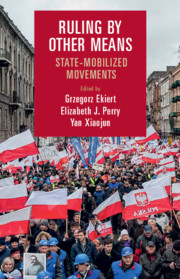Book contents
- Ruling by Other Means
- Cambridge Studies in Contentious Politics
- Ruling by Other Means
- Copyright page
- Contents
- Figures
- Tables
- Contributors
- Acknowledgments
- 1 State-Mobilized Movements: A Research Agenda
- 2 Manufactured Ambiguity
- 3 Suppressing Students in the People’s Republic of China
- 4 State-Mobilized Community Development
- 5 Enforcement Networks and Racial Contention in Civil Rights–Era Mississippi
- 6 Social Sources of Counterrevolution
- 7 Occupy Youth!
- 8 State-Mobilized Movements after Annexation of Crimea
- 9 Mirroring Opposition Threats
- 10 Mobilizing against Change
- 11 The Dynamics of State-Mobilized Movements
- 12 State-Mobilized Campaign and the Prodemocracy Movement in Hong Kong, 2013–2015
- 13 The Resurrection of Lei Feng
- Index
- Books in the Series (continued from p.iii)
- References
6 - Social Sources of Counterrevolution
State-Sponsored Contention during Revolutionary Episodes
Published online by Cambridge University Press: 29 July 2020
- Ruling by Other Means
- Cambridge Studies in Contentious Politics
- Ruling by Other Means
- Copyright page
- Contents
- Figures
- Tables
- Contributors
- Acknowledgments
- 1 State-Mobilized Movements: A Research Agenda
- 2 Manufactured Ambiguity
- 3 Suppressing Students in the People’s Republic of China
- 4 State-Mobilized Community Development
- 5 Enforcement Networks and Racial Contention in Civil Rights–Era Mississippi
- 6 Social Sources of Counterrevolution
- 7 Occupy Youth!
- 8 State-Mobilized Movements after Annexation of Crimea
- 9 Mirroring Opposition Threats
- 10 Mobilizing against Change
- 11 The Dynamics of State-Mobilized Movements
- 12 State-Mobilized Campaign and the Prodemocracy Movement in Hong Kong, 2013–2015
- 13 The Resurrection of Lei Feng
- Index
- Books in the Series (continued from p.iii)
- References
Summary
The Orange Revolution from November 21, 2004, through January 10, 2005, is widely considered one of the most spectacular displays of revolutionary protest on the European continent since the end of the Cold War. Over a two-week span, up to a million citizens turned out on Maidan, the main square of Kiev, in temperatures as cold as minus 12 degrees centigrade to demand the annulment of falsified elections and an end to the incumbent regime of Leonid Kuchma and his chosen successor, Viktor Yanukovych. On November 23, Orange candidate Viktor Yushchenko was sworn in as president on Maidan in front of a large crowd of onlookers – even before the fraudulent electoral results declaring pro-incumbent candidate Viktor Yanukovych as winner were announced. There were several key turning points in the revolution: the defection of pro-Kuchma legislators in voting no-confidence in the Electoral Commission on November 27 (and later their dismissal of Yanukovych as prime minister on December 1); the abandoned effort on November 28 to use force to gain back control over the situation; and the remarkable display of independence on December 3 by members of the Ukrainian Supreme Court to invalidate the election, leading to new elections on December 26 in which Yushchenko won with 52 percent of the vote, resolving the situation of dual power in favor of the opposition.
- Type
- Chapter
- Information
- Ruling by Other MeansState-Mobilized Movements, pp. 140 - 165Publisher: Cambridge University PressPrint publication year: 2020
References
- 3
- Cited by



